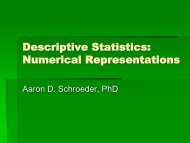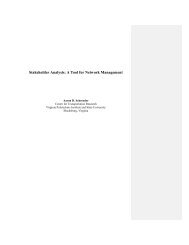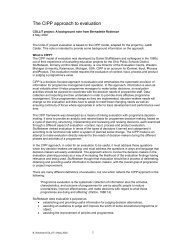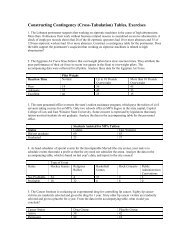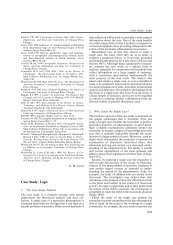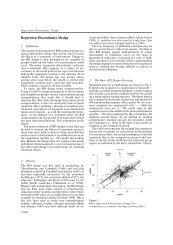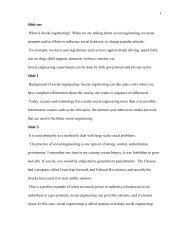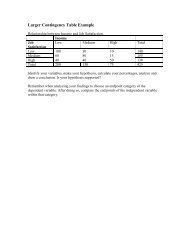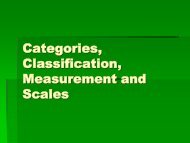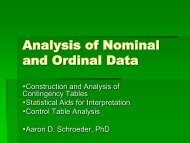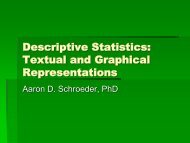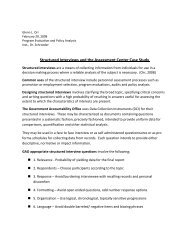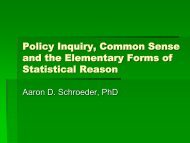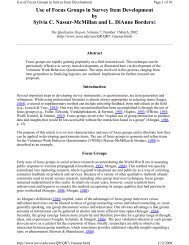Linear Regression
Linear Regression
Linear Regression
You also want an ePaper? Increase the reach of your titles
YUMPU automatically turns print PDFs into web optimized ePapers that Google loves.
Introduction to<br />
<strong>Linear</strong> <strong>Regression</strong><br />
Aaron D. Schroeder, PhD
Relationships<br />
• Just like viewing things as “ordinary or not” is a<br />
necessity of the human condition, so is looking at the<br />
relationships between things<br />
• It’s a great shortcut<br />
• Imagine if you had to wonder every time you got in your car<br />
what was going to happen when you step on the accelerator<br />
• Instead, we assume a relationship exists that we ca count on –<br />
we don’t need to rethink it every time<br />
• The concepts of average and deviation are simply<br />
statistical formalizations of “ordinary or not”<br />
• <strong>Linear</strong> <strong>Regression</strong> is simply a statistical formalization of<br />
the concept of relationship
• Many public management problems can be<br />
interpreted as relationships between two<br />
variables<br />
• Highway patrol might want to know whether the avg.<br />
speed of motorists is related to the number of cars<br />
on patrol<br />
• Knowing this could lead to decision to increase/decrease<br />
patrols<br />
• A state wants to raise the beer tax and wants to<br />
know how much revenue it would generate<br />
• If a relationship exists between, say, population and<br />
revenue from beer tax, then a “prediction” can be made as<br />
to how much revenue the state could expect to receive
Functional vs. Statistical<br />
• Relationships can be categorized as<br />
functional or statistical<br />
• Functional Relationship<br />
• one variable (Y) is a direct function of<br />
another (X)<br />
• Statistical Relationship<br />
• one where knowing the value of an<br />
Independent variable will let you estimate a<br />
value for the Dependent variable
Functional<br />
Relationship<br />
• Cooter Davenport, the<br />
head of the Hazard<br />
County motor pool,<br />
believes there is a<br />
relationship between the<br />
number of cars he sends<br />
over to a local tune-up<br />
shop and the amount of<br />
the bill that he receives<br />
• Cooter finds the<br />
information for the last<br />
five transactions with the<br />
tune-up shop<br />
Data from Tune-Up Shop<br />
Number of Cars Amount of Bill<br />
2 $64<br />
1 32<br />
5 160<br />
4 128<br />
2 64
Functional Relationship<br />
• Cooter, having recently<br />
audited a methods course,<br />
knows the first step you<br />
should always take in<br />
determining whether two<br />
variables are related is to<br />
graph the two variables<br />
• When graphing, the<br />
Independent variable (X) is<br />
always graphed along the<br />
bottom horizontally, and the<br />
Dependent variable is always<br />
graphed along the side<br />
vertically
Functional Relationship<br />
• Task<br />
• Go ahead and<br />
graph Cooter’s<br />
data<br />
Data from Tune-Up Shop<br />
Number of Cars Amount of Bill<br />
2 $64<br />
1 32<br />
5 160<br />
4 128<br />
2 64
Functional Relationship<br />
• What was the result?<br />
• The data should fall without deviation along a<br />
single line<br />
• This is a characteristic of a functional<br />
relationship<br />
• If you know the value of the independent variable,<br />
then you know, exactly, the value of the dependent<br />
variable<br />
• The tune-up shop charges $32 to tune up a<br />
car, so the bill is simply $32 times the number<br />
of cars
Statistical Relationships<br />
and <strong>Regression</strong><br />
• Unfortunately, VERY FEW of the important<br />
relationships that public managers must<br />
consider are functional<br />
• Most relationships are Statistical<br />
• Knowing the Independent variable only lets us<br />
estimate the Dependent variable<br />
• One tool (process) for determining the exact<br />
nature of a statistical relationship is called<br />
<strong>Regression</strong>
Statistical Relationships<br />
and <strong>Regression</strong><br />
Example<br />
• The Commissioner of VDOT<br />
believes the average speed<br />
of motorists along a stretch of<br />
I-81 is related to the number<br />
of cars patrolling that stretch<br />
• Average speed is measured<br />
by and unmanned, stationary<br />
radar gun<br />
• Experiment spans 2 months<br />
with measurements taken<br />
daily<br />
• A sample of 5 days is taken<br />
Number of Cars<br />
Patrolling<br />
Commissioner's Data<br />
Average Speed<br />
of Motorists<br />
3 64<br />
1 71<br />
4 61<br />
5 58<br />
7 56
Statistical Relationships<br />
and <strong>Regression</strong><br />
• The first step is<br />
to plot the data<br />
on a graph to<br />
see if we SEE a<br />
relationship<br />
• This is called<br />
“Eyeballing”
Statistical Relationships<br />
and <strong>Regression</strong><br />
• Clearly, a<br />
relationship seems<br />
to exist<br />
• The more patrol<br />
cars on the<br />
highway, the lower<br />
the average speed<br />
• What kind of<br />
relationship is this?<br />
• Negative
Statistical Relationships<br />
and <strong>Regression</strong><br />
• Another example<br />
• Our hypothetical<br />
beer tax scenario<br />
illustrates a<br />
positive<br />
relationship<br />
• We can see that<br />
as a states’<br />
populations<br />
increase, so do<br />
the revenues from<br />
the beer tax
Statistical Relationships<br />
and <strong>Regression</strong><br />
• Many times, no<br />
relationship exists<br />
between two<br />
variables<br />
• Here’s a graph of<br />
the data relating<br />
the number of<br />
patrol cars to the<br />
number of<br />
indecent exposure<br />
arrests<br />
• Need to look at<br />
data
Statistical Relationships<br />
and <strong>Regression</strong><br />
• OK, what if there was a<br />
national Public<br />
Administration<br />
conference held in town<br />
on Wed-Fri (these folks<br />
are known to be wild)<br />
and graduation frm a<br />
local University was on<br />
Saturday?<br />
• How might you control<br />
for such things?<br />
Patrol Cars and Number of Arrests<br />
Day<br />
Cars on<br />
Patrol<br />
Indecent<br />
Exposure<br />
Arrests<br />
Monday 2 27<br />
Tuesday 3 12<br />
Wednesday 3 57<br />
Thursday 7 28<br />
Friday 1 66<br />
Saturday 6 60
Eyeballing<br />
• You can figure out a lot by first graphing the<br />
two variables and taking a gander<br />
• You can generally tell pretty quickly when a<br />
VERY STRONG or VERY WEAK IF ANY<br />
relationship exists<br />
• However, many situations will fall somewhere<br />
in between<br />
• That’s when you need to have a set of statistics<br />
on hand to help you summarize the data
Centrality and Spread<br />
• Remember, to describe some data about ONE<br />
variable accurately, we need two things<br />
• A measure of Centrality<br />
• And a measure of Spread<br />
• When doing regression, even though it is more<br />
difficult (because we are now dealing with<br />
TWO data sets), we are still trying to find the<br />
same things!
Statistical Relationships<br />
and <strong>Regression</strong><br />
• The measure<br />
of Centrality,<br />
when we are<br />
dealing with<br />
TWO<br />
variables, is<br />
• a LINE
Statistical Relationships<br />
and <strong>Regression</strong><br />
• For our example of<br />
patrol cars on I-81,<br />
we see that we can<br />
pretty easily draw a<br />
line that can “sum<br />
up” the relationship<br />
between the two<br />
variables<br />
• The line<br />
represents the<br />
“average”<br />
outcome of Y for<br />
any given X
Statistical Relationships and <strong>Regression</strong>:<br />
Two Numbers Describe a Line<br />
• Any line can be<br />
described by two<br />
numbers<br />
• The 3 lines here<br />
differ in how<br />
steeply they<br />
“slant”<br />
• This slant is<br />
referred to a<br />
Slope
Statistical Relationships and <strong>Regression</strong>:<br />
Two Numbers Describe a Line<br />
• The slope of<br />
any line is<br />
defined by how<br />
much the line<br />
rises or falls<br />
relative to the<br />
distance it<br />
travels<br />
horizontally
Statistical Relationships and <strong>Regression</strong>:<br />
Two Numbers Describe a Line<br />
• Statistically, the formula<br />
is<br />
<br />
<br />
<br />
• Remember “rise over<br />
run”?<br />
• Because we are most<br />
often dealing with<br />
samples, we use the<br />
symbol “b”<br />
• In geometry, it was “m”
Statistical Relationships and <strong>Regression</strong>:<br />
Two Numbers Describe a Line<br />
• Here a several<br />
hypothetical<br />
lines<br />
• Go ahead and<br />
calculate the<br />
slopes
Statistical Relationships and <strong>Regression</strong>:<br />
Two Numbers Describe a Line<br />
• The second number<br />
used to describe a<br />
line is the point<br />
where it crosses Y-<br />
axis<br />
• This is where X = 0<br />
• It’s called the<br />
Intercept<br />
• Here are several<br />
line with the same<br />
slope, but different<br />
intercepts
Statistical Relationships and <strong>Regression</strong>:<br />
Two Numbers Describe a Line<br />
• Statistically, we<br />
refer to the intercept<br />
with the Greek letter<br />
alpha “α”<br />
• Since we are<br />
usually dealing with<br />
samples, we<br />
instead use “a”<br />
• In geometry you<br />
used “b”, how’s that<br />
for confusing?
Statistical Relationships and <strong>Regression</strong>:<br />
Two Numbers Describe a Line<br />
• So, a line can be<br />
described as<br />
<br />
<br />
<br />
• If you are<br />
describing a<br />
relationship,<br />
then it’s<br />
ˆ
Statistical Relationships and <strong>Regression</strong>:<br />
Two Numbers Describe a Line<br />
ˆ<br />
<br />
• The little “hat”<br />
means “predicted<br />
value”<br />
• Because we are<br />
usually dealing with<br />
samples, we use<br />
ˆ<br />
<br />
a<br />
<br />
b<br />
• In geometry it was<br />
Y=mX + b, go figure
Statistical Relationships and <strong>Regression</strong>:<br />
Two Numbers Describe a Line<br />
• To illustrate, let’s<br />
look at the car<br />
speed example<br />
again<br />
• If we had only the<br />
line, what could we<br />
say about the<br />
expected average<br />
speed if 3 patrol<br />
cars were on the<br />
road?
Statistical Relationships and <strong>Regression</strong>:<br />
Two Numbers Describe a Line<br />
• Note that the actual<br />
value for that day is<br />
64<br />
• There is going to<br />
be some error in<br />
predicting Y<br />
ˆ<br />
i<br />
<br />
i<br />
e<br />
i<br />
• Just like if we use<br />
the mean to predict<br />
a parameter
Statistical Relationships and <strong>Regression</strong>:<br />
Two Numbers Describe a Line<br />
• It’s often very hard to accurately eyeball a<br />
line<br />
• Sometimes, multiple lines look they might do<br />
the trick<br />
• Statisticians have figured out that best line to<br />
approximate a relationship between two<br />
variables is the one that minimizes the errors<br />
between Y and Y “hat”<br />
• This is called “<strong>Linear</strong> <strong>Regression</strong>” or<br />
“Ordinary Least Squares”<br />
ˆ<br />
i<br />
<br />
i<br />
<br />
e<br />
i
Statistical Relationships and <strong>Regression</strong>:<br />
Two Numbers Describe a Line<br />
• The two formulas<br />
that determine a line<br />
according to linear<br />
regression are<br />
• The slope<br />
b<br />
X<br />
<br />
i<br />
X Yi<br />
Y<br />
X<br />
X <br />
i<br />
<br />
2<br />
• The intercept<br />
a<br />
Y<br />
bX
Statistical Relationships and <strong>Regression</strong>:<br />
Two Numbers Describe a Line<br />
• The Slope<br />
• Taken a piece at a time, this<br />
formula is not as intimidating<br />
as it looks<br />
• Example – Patrol Cars vs.<br />
Speed<br />
• Step 1<br />
• Calculate the mean for both<br />
the dependent variable (Y)<br />
and the Independent variable<br />
(X)<br />
b<br />
Number of Cars<br />
Patrolling (X)<br />
X<br />
<br />
i<br />
X Yi<br />
Y<br />
X<br />
X <br />
i<br />
<br />
2<br />
Commissioner's Data<br />
Average Speed<br />
of Motorists (Y)<br />
3 64<br />
1 71<br />
4 61<br />
5 58<br />
7 56<br />
mean = 4 mean = 62
Statistical Relationships and <strong>Regression</strong>:<br />
Two Numbers Describe a Line<br />
• Step 2<br />
• Subtract the mean of the<br />
dependent variable from<br />
each value of the<br />
dependent variable<br />
• Do the same for the<br />
independent variable<br />
b<br />
X i <br />
X<br />
X<br />
<br />
i<br />
X Yi<br />
Y<br />
X<br />
X <br />
i<br />
<br />
2<br />
Y i <br />
Y<br />
3 - 4 = -1 64 – 62 = 2<br />
1 – 4 = -3 71 – 62 = 9<br />
4 – 4 = 0 61 – 62 = -1<br />
5 – 4 = 1 58 – 62 = -4<br />
7 – 4 = 3 56 – 62 = -6
Statistical Relationships and <strong>Regression</strong>:<br />
Two Numbers Describe a Line<br />
• Step 3<br />
• Multiply the value you get<br />
when you subtract the mean<br />
from X i by the value you get<br />
when you subtract the mean<br />
from Y i<br />
• Step 4<br />
• Sum em up! You should get -<br />
51<br />
• We now have the numerator<br />
(the one on top)<br />
b<br />
X<br />
<br />
i<br />
X Yi<br />
Y<br />
X<br />
X <br />
i<br />
<br />
2<br />
X<br />
X Y<br />
Y<br />
<br />
i<br />
-1 x 2 = -2<br />
-3 x 9 = -27<br />
0 x -1 = 0<br />
1 x -4 = -4<br />
3 x -6 = -18<br />
i
Statistical Relationships and <strong>Regression</strong>:<br />
Two Numbers Describe a Line<br />
• Step 5<br />
• Use the (X i – X bar )<br />
column from step 3, and<br />
square each value<br />
• Step 6<br />
• Sum em up!<br />
• You should get 20<br />
• We now have the<br />
denominator (the one on<br />
the bottom)<br />
b<br />
X<br />
<br />
i<br />
X Yi<br />
Y<br />
X<br />
X <br />
i<br />
<br />
2<br />
X X i<br />
2<br />
X i<br />
X<br />
3 - 4 = -1 1<br />
1 – 4 = -3 9<br />
4 – 4 = 0 0<br />
5 – 4 = 1 1<br />
7 – 4 = 3 9
Statistical Relationships and <strong>Regression</strong>:<br />
Two Numbers Describe a Line<br />
• Step 7<br />
• Divide the numerator by<br />
the denominator!<br />
• Your slope is -2.55<br />
b<br />
X<br />
<br />
i<br />
X Yi<br />
Y<br />
X<br />
X <br />
i<br />
<br />
2<br />
b <br />
51 2.55<br />
20
Statistical Relationships and <strong>Regression</strong>:<br />
Two Numbers Describe a Line<br />
• The Intercept<br />
• Much easier<br />
• Just substitute in the<br />
three values you already<br />
have for b, the mean of<br />
X and the mean of y<br />
• The intercept is 72.2<br />
a<br />
<br />
Y<br />
<br />
bX<br />
<br />
2.554<br />
62 10.2 72. 2<br />
a 62
Statistical Relationships and <strong>Regression</strong>:<br />
Two Numbers Describe a Line<br />
• So, the regression<br />
equation that<br />
describes the<br />
relationship<br />
between the<br />
number of patrol<br />
cars and average<br />
speed on a stretch<br />
of I81 is:<br />
Yˆ<br />
72.2 2. 55X
Applying the <strong>Regression</strong><br />
Equation<br />
• The regression equation<br />
provides a lot of<br />
information<br />
• Suppose the VDOT<br />
commissioner wants to<br />
know the estimated<br />
average speed of traffic<br />
if six patrol cars are<br />
placed on duty<br />
• Just plug it in to your new<br />
equation<br />
• We can expect an<br />
average speed of 56.9<br />
Yˆ<br />
X<br />
Yˆ<br />
Yˆ<br />
Yˆ<br />
72.2 2.55X<br />
<br />
<br />
<br />
<br />
6<br />
<br />
cars<br />
<br />
72.2 2.55<br />
72.2 15.3<br />
56.9<br />
6
Applying the <strong>Regression</strong><br />
Equation<br />
Yˆ<br />
72.2 2. 55X<br />
• How much would the mean speed for all<br />
cars decrease if one additional patrol car<br />
were added?<br />
• Hint: every time you add one car, it gets<br />
multiplied by this<br />
• The regression coefficient is the slope<br />
• In management, it is interpreted as “How<br />
much will Y change for every unit change in<br />
X?”
Applying the <strong>Regression</strong><br />
Equation<br />
Yˆ<br />
72.2 2. 55X<br />
• What would be the average speed be<br />
if no patrol cars were on the road?<br />
• This means when X = 0<br />
• Another way to state it is “What is the<br />
Y-intercept?”
<strong>Regression</strong> Example<br />
• While you will usually use Excel or a<br />
stats program to calculate regression<br />
equations, it is a good idea to calculate<br />
some by hand so that you understand<br />
what it is the computer is doing for you<br />
• As we’ve seen in the previous<br />
walkthrough, it’s not that difficult
<strong>Regression</strong> Example<br />
• Using the provided worksheet, create the<br />
regression equation that describes the<br />
relationship between a state’s population<br />
and its beer tax revenue
<strong>Linear</strong> <strong>Regression</strong><br />
Measures of Goodness of Fit<br />
• When we use a mean to summarize the data of<br />
one variable, it is meaningless without some<br />
measure of the dispersion of the data around<br />
that mean (e.g. standard deviation)<br />
• The same holds for linear regression<br />
• While a line can be used to describe the<br />
relationship between two variables, it does not,<br />
by itself, tell us how well it is summarizing the<br />
data
<strong>Linear</strong> <strong>Regression</strong><br />
Measures of Goodness of Fit<br />
• To illustrate, the two sets of data above can be<br />
summarized by the same regression line<br />
• However, we can see that the data has a<br />
“better fit” around the line of the second graph
<strong>Linear</strong> <strong>Regression</strong><br />
Measures of Goodness of Fit<br />
• The distance a data point is from the regression line is its error<br />
• Recall that ˆ<br />
i<br />
i<br />
ei<br />
• Measures of Goodness of Fit are what statisticians have come up<br />
with to describe the amount of error in predictions made by our<br />
regression equation
<strong>Linear</strong> <strong>Regression</strong><br />
Measures of Goodness of Fit<br />
• Error, when we are talking about regression<br />
equations, is referred to as Unexplained<br />
Variance<br />
• That is, it’s the part that knowing X can’t<br />
explain
<strong>Linear</strong> <strong>Regression</strong><br />
Measures of Goodness of Fit<br />
• Where does error come from?<br />
• It is very rare that a single independent variable will<br />
account for all the variation in a dependent variable<br />
• The unemployment rate might explain a substantial<br />
portion of the variation in demand for services at a local<br />
food bank, but other variables such as higher retail<br />
food prices and climate (such as cold weather) might<br />
also account for some of the variation in demand<br />
• Data values will not fall perfectly along a regression<br />
line if the independent variable only explains some of<br />
the variation in the dependent variable
<strong>Linear</strong> <strong>Regression</strong><br />
Measures of Goodness of Fit<br />
• Measuring goodness of fit of the data<br />
around a regression equation IS more<br />
complicated than measuring dispersion<br />
around a mean<br />
• This is because there are multiple places<br />
for the things to vary<br />
• Specifically, there are two major places<br />
that error an be a factor
<strong>Linear</strong> <strong>Regression</strong><br />
Measures of Goodness of Fit<br />
• How much an<br />
estimate is off from<br />
the actual data point<br />
is called a “residual”<br />
• There are two<br />
methods to analyze<br />
how much residual<br />
error there is<br />
• Standard Error of<br />
the Estimate<br />
• Coefficient of<br />
Determination<br />
Residual
<strong>Linear</strong> <strong>Regression</strong><br />
Measures of Goodness of Fit<br />
• The angle of the<br />
slope (the<br />
regression<br />
coefficient) can<br />
also be off<br />
• The method<br />
used to asses<br />
this is called the<br />
Standard Error<br />
of the Slope<br />
Error in the Slope
The Standard Error of the Estimate<br />
• An calculation of the variation<br />
in the predicted Ys (the<br />
estimates)<br />
• Basically the standard<br />
deviation of linear regression<br />
(sums up the squared<br />
differences from the line and<br />
divides by n; actually n-2, but<br />
you get the idea)<br />
• Can be used to put<br />
confidence bands around the<br />
regression line
The Standard Error of the Estimate<br />
• The formula is<br />
S<br />
y|<br />
x<br />
<br />
<br />
Yi<br />
Y<br />
n 2<br />
<br />
ˆ 2<br />
• If you put Y-bar in<br />
the place of Y-hat,<br />
you almost exactly<br />
have the equation for<br />
standard deviation
The Standard Error of the Estimate<br />
• To illustrate<br />
• Using data from car<br />
speed example<br />
• Step 1<br />
• First we need to find all<br />
the predicted Ys for our<br />
Xs<br />
• That means we plug in our<br />
values of X into the<br />
regression equation we<br />
made<br />
S<br />
Number of Cars<br />
Patrolling (X)<br />
y|<br />
x<br />
<br />
<br />
Yi<br />
Y<br />
n 2<br />
<br />
ˆ 2<br />
Average Speed of<br />
Motorists (Y)<br />
3 64<br />
1 71<br />
4 61<br />
5 58<br />
7 56<br />
mean = 4 mean = 62<br />
Yˆ<br />
72.2 2. 55X
The Standard Error of the Estimate<br />
• To illustrate<br />
• Using data from car<br />
speed example<br />
• Step 1<br />
• First we need to find all<br />
the predicted Ys for our<br />
Xs<br />
• That means we plug in our<br />
values of X into the<br />
regression equation we<br />
made<br />
Number of<br />
Cars<br />
Patrolling (X)<br />
S<br />
y|<br />
x<br />
<br />
Average<br />
Speed of<br />
Motorists (Y)<br />
<br />
Yi<br />
Y<br />
n 2<br />
3 64 64.6<br />
1 71 69.7<br />
4 61 62.0<br />
5 58 59.5<br />
7 56 54.4<br />
<br />
ˆ 2<br />
Predicted<br />
Speed of<br />
Motorists (Yhat)<br />
Yˆ<br />
72.2 2. 55X
The Standard Error of the Estimate<br />
• Step 2<br />
• Now we can<br />
subtract each<br />
Y-hat from the<br />
actual Y<br />
• Step 3<br />
• Square the<br />
errors found in<br />
step 2 and<br />
sum them up<br />
Number<br />
of Cars<br />
Patrolling<br />
(X)<br />
S<br />
y|<br />
x<br />
Average<br />
Speed of<br />
Motorists<br />
(Y)<br />
<br />
<br />
Yi<br />
Y<br />
n 2<br />
Predicted<br />
Speed of<br />
Motorists<br />
(Y-hat)<br />
<br />
ˆ 2<br />
3 64 64.6 .36<br />
Y 2<br />
i<br />
Ŷ<br />
1 71 69.7 1.69<br />
4 61 62.0 1.00<br />
5 58 59.5 2.25<br />
7 56 54.4 2.56<br />
∑ 7.86
The Standard Error of the Estimate<br />
• Step 4<br />
• Divide by n-2<br />
• Step 5<br />
• Take the<br />
square root<br />
• The Standard<br />
Error of the<br />
Estimate is<br />
1.62<br />
S y<br />
S<br />
y|<br />
x<br />
<br />
<br />
Yi<br />
Y<br />
n 2<br />
<br />
ˆ 2<br />
7.86<br />
| x<br />
2.62 1.62<br />
3
The Standard Error of the Estimate<br />
• OK, so, yippee, I have a regression<br />
equation and a Standard Error of the<br />
Estimate, now what?<br />
• Well, suppose the VDOT commissioner<br />
wanted to predict the average speed of all<br />
cars when three patrol cars were on the<br />
road<br />
• Using the regression equation, the commish<br />
would find<br />
• Y = 72.2 – 2.55(3) = 64.55 mph
The Standard Error of the Estimate<br />
• Y = 72.2 – 2.55(3) = 64.55 mph<br />
• But how “confident” can the commish be in that<br />
estimate?<br />
• Now that we have the Standard Error of the Estimate,<br />
we can answer that<br />
• Lets say the commish wanted to be 90% confident<br />
• Degrees of freedom for regression is n – 2, (5 – 2 = 3)<br />
• Look up the t-score for .10 at 3df<br />
• If you have a chart that shows only one-tailed, then look under .05<br />
at 3df<br />
• You should get 2.35<br />
• Multiply that by your Standard Error 2.35 x 1.62 = 3.81<br />
• The commish can be 90% confident that the speeds will<br />
be 64.55 mph ± 3.81 mph
Not exactly, but close “enuf”<br />
• This formula is most accurate at the middle of<br />
the line<br />
• With smaller n, the confidence bands actually<br />
bow<br />
• As n gets higher, the bow goes away<br />
• Much fancier formula that takes the bow into<br />
account<br />
• Your computer program will automatically do<br />
this for you
The Coefficient of Determination<br />
• The ratio of Explained<br />
Variation to the Total<br />
Variation<br />
• Explained variation is<br />
nothing more than the<br />
total variation minus the<br />
error<br />
• The formula is<br />
• It ranges from 0 (the line<br />
doesn’t fit the data at all)<br />
to 1 (the line perfectly<br />
describes the data)<br />
r<br />
2<br />
<br />
ˆ<br />
<br />
Y Y<br />
i<br />
Y Y<br />
i<br />
2<br />
<br />
2
The Coefficient of Determination<br />
2<br />
• Your looking at the<br />
difference between<br />
the variation in you<br />
predicted scores<br />
around the mean<br />
vs. the variation in<br />
the actual scores<br />
around the mean<br />
r<br />
<br />
<br />
Yˆ<br />
i<br />
Y<br />
Y<br />
i<br />
Y<br />
<br />
2<br />
<br />
2
The Coefficient of Determination<br />
2<br />
• Think about it this way<br />
• If someone wanted to guess the next value of<br />
Y but gave you no information, you would have<br />
to guess the mean<br />
• If someone asked you to guess the next value,<br />
but gave you an X and a regression equation,<br />
you could probably get closer to the actual<br />
value than just guessing the mean<br />
• The difference between these two is what r 2 is<br />
measuring<br />
r<br />
<br />
<br />
Yˆ<br />
i<br />
Y<br />
Y<br />
i<br />
Y<br />
<br />
2<br />
<br />
2
The Coefficient of Determination<br />
Y bar = 62<br />
r<br />
<br />
<br />
Yˆ<br />
i<br />
Y<br />
Y<br />
i<br />
Y<br />
<br />
2<br />
<br />
2<br />
2<br />
Y hat (predicted) Y (actual) (Y hat – Y bar ) 2 (Y – Y bar ) 2<br />
64.6 64<br />
69.7 71<br />
62.0 61<br />
59.5 58<br />
54.4 62<br />
∑<br />
r 2 =
The Coefficient of Determination<br />
2<br />
• What’s is good for?<br />
• Kind of a one-stop shopping stat<br />
• Some % of Y is “explained” by X<br />
• Most useful for comparing one model to the<br />
next when trying to figure out which<br />
Independent variable is the most important<br />
• Or for figuring out if you need to go find<br />
more variables!<br />
• Actually quite overused<br />
r<br />
<br />
<br />
Yˆ<br />
i<br />
Y<br />
Y<br />
i<br />
Y<br />
<br />
2<br />
<br />
2
The Standard Error of the Slope<br />
• Whereas the Standard Error of the<br />
Estimate is like the Standard Deviation,<br />
the Standard Error of the Slope is like the<br />
Standard Error, goofy language huh?<br />
• If we took several samples of an<br />
independent and dependent variable and<br />
calculated a slope, it would be a little<br />
different every time
The Standard Error of the Slope<br />
• Just like the Standard Error is an<br />
estimate of variation based on the<br />
Sample Distribution of Means, the<br />
Standard Error of the Slope also relates<br />
the sample to a sample distribution<br />
• Therefore, just like we can use the s.e. of<br />
a single variable data set to create a t-<br />
score and test a hypothesis, we can do<br />
the same for our regression equation
The Standard Error of the Slope<br />
• The formula is:<br />
s<br />
b<br />
<br />
<br />
S<br />
y|<br />
x<br />
• You already have the<br />
numerator (it’s the<br />
Standard Error of the<br />
Estimate)<br />
X<br />
i<br />
<br />
X<br />
<br />
2<br />
X<br />
3<br />
1<br />
4<br />
5<br />
7<br />
∑<br />
X<br />
4<br />
X X 2<br />
s b =
The Standard Error of the Slope<br />
• So what’s it good for?<br />
• Just like the Standard Error of the Estimate,<br />
you could multiply it by 2.35 and get a 90%<br />
confidence band around your estimate of the<br />
slope (-3.40 to -1.70)<br />
• I’m not really sure what you would use that<br />
for though<br />
• More importantly, you can do a significance<br />
test with it to test a hypothesis
The Standard Error of the Slope<br />
• The Null Hypothesis for a<br />
regression equation is always<br />
β=0 (that is, that the slope of<br />
the population is 0, or that<br />
there is no relationship<br />
between the two variables)<br />
• So, to get a t-score, you just<br />
subtract 0 from your slope (b)<br />
and divide by the standard<br />
error of the slope (s b )<br />
• Give it a shot!<br />
t<br />
<br />
b<br />
<br />
s b
The Standard Error of the Slope<br />
• Now, look at a t-distribution table<br />
for 3 degrees of freedom<br />
• How far over can you go before<br />
you get higher than the t-score<br />
you just got?<br />
• Should be something like .005<br />
• That means the probability that a<br />
sample with a slope of -2.55<br />
could have been drawn from a<br />
population with a slope of zero is<br />
less than .005 (5 in 1000)<br />
• Pretty good odds that some form<br />
of relationship exists!<br />
t<br />
<br />
b<br />
<br />
s b
The Standard Error of the Slope<br />
• Sometimes a regression equation is computed on a<br />
whole population<br />
• Remember, when this is the case, any finding is %100<br />
probable (you are not estimating with error)<br />
• You don’t need to test for significance in this case<br />
• Many times, you will still see this done<br />
• This is goofy and shows that they have idea why they<br />
are running the tests they are running<br />
• I’m sure it won’t directly effect their self esteem, but stats<br />
geeks are laughing at them
To summarize<br />
• <strong>Regression</strong> describes the relationship between two<br />
interval variables<br />
• The relationship can be described by a line<br />
• Any line can be summarized by its slope and intercept<br />
• “<strong>Linear</strong>” regression finds the line by minimizing the error<br />
around the line<br />
• The three techniques used to test the “Goodness of Fit”<br />
of the data around the line are:<br />
• The Standard Error of the Estimate which estimates the<br />
variation in the predicted values of Y<br />
• The Coefficient of Determination which gives you a total<br />
reading of the variation in Y and ranges from 0-1<br />
• The Standard Error of the Slope which can be used to test the<br />
null hypothesis, β=0



